Mailing List
Sign up for our mailing list to get latest updates and offers.
Cultural Tourism
Despite its small size (10,452 KM²), Lebanon is extremely rich in culture. Renowned sites such as Roman temple Baalbek and the extraordinary Jeita Grottos are only a snippet of the cultural wonders to be discovered throughout the country.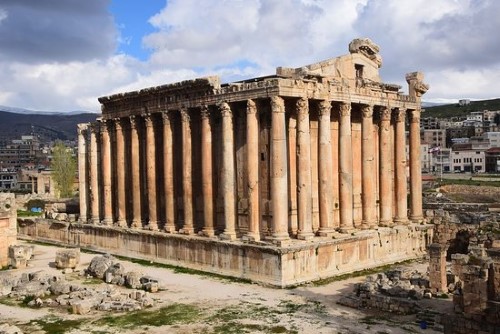
Baalbek
At an ancient cross-road connecting the coast with the Syrian interior and North Syria with North Palestine, Baalbek lays with its huge temples considered among the wonders of the Ancient world. Baalbek overlooks the Bekaa plain and is a witness of an imperial project that embodies the Roman determination, wealth and power.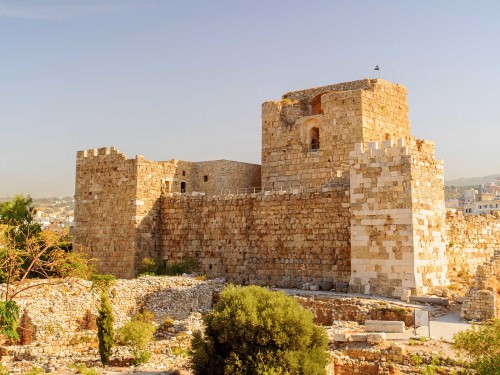
Byblos
It is one of the oldest cities in the world. It is also one of the rare sites that have continuously been inhabited and their foundation excavations show that it dates back to the 6th millennium B.C.
Anjar
An entire palace-city from the Umayyad dynasty today lies in ruins. The name “Anjar” is a modification of the Arabic “Ain Gerrha,” the name of an ancient city founded in this area in Hellenistic times.
In contrast with other historic cities in Lebanon that are still inhabited, such as Tyre, Saida, Beirut and Byblos, Anjar’s glory did not last long because of the Umayyad’s short-lived 100-year rule in the 8th century. Today, a large Armenian population lives around Anjar, which incidentally means “unresolved or running river.”
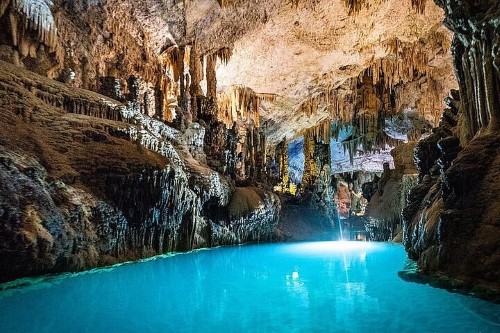
Jeita Grotto
Fashioned by millions of years of erosion, the Jeita Grotto is a real feast for the eyes. Six kilometers wide, 18 kilometers deep and once only accessible by boat through an underground river, the cave system is magical and fascinating.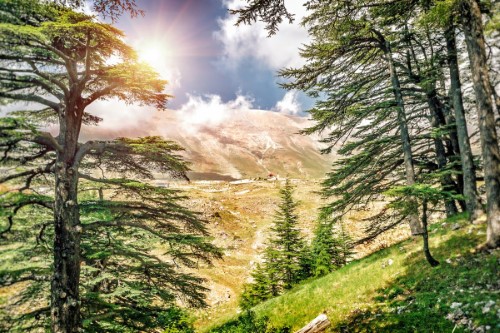
The Cedars
At more than 1,800 meters above sea level, the cedars of Lebanon fascinate with their majesty and great age. Known for their long-lasting wood resistant to temperatures, humidity and decay, the trees were widely exploited in antiquity. In the Phoenician era, cedar wood was exported in bulk mainly to Egypt and the Phoenician colonies of the Mediterranean.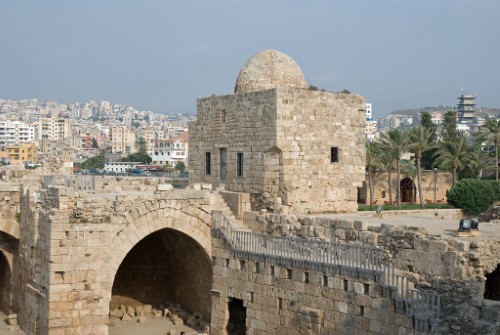
Sidon
Sidon (or Saidoon) is a vital commercial and administrative center with a fascinating and unique history. One of the most powerful Phoenician city states, it made a name for itself the world over with its expert glass manufacturing and the invention of purple dye, which has ever since been synonymous with royalty.
Tyre
Tyre, the Phoenician city, was the queen of the seas. It was built on an island and became well known to the people who lived around the Mediterranean Sea for its wealth and prosperity. It was famous for its industry of purple-dyed textiles, thus attracting the great conquerors in ancient times. Among them we mention the Babylonian king, Nebuchadnezzar and Alexander the Great.
Beiteddine
Just a few kilometers from the fascinating village of Deir el Qamar is the palace of Beiteddine, a masterpiece of 19th century Lebanese architecture. The palace, with its vast courtyard and beautiful fountains, ochre stone and perfectly geometrical arcades is a wonderful site to behold.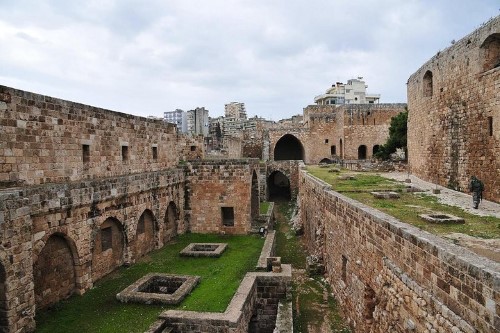
Tripoli, St Gilles’ Fortress
The most important touristic sites of Tripoli are situated around the Crusader Castle, where the "souk" as well as Mamluk and Ottoman ruins are found.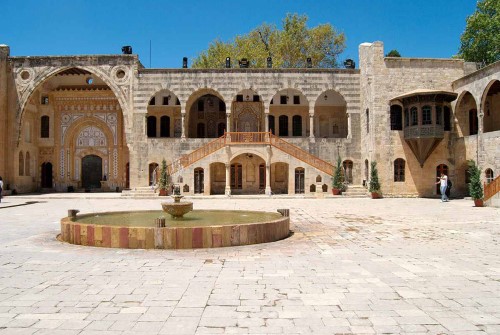
Deir el Qamar
It is an old town hemmed in an urban frame that maintained the architectural prosperities of the 17th and 18th centuries. This pattern continues until you reach Beiteddine. In the old beautiful streets, gardens blossoming with roses and jasmine attract one's sight, besides the outdoor stone benches that belong to the houses, and which are filled with vines dangling in front of the houses, the flower beds and the houses and narrow streets. All of this makes the town a scenic place.
Gastronomy & Oenology
GASTRONOMY
Lebanon may be one of the smallest countries in the world but its cuisine has certainly made a name for itself. Wholesome, fresh, colorful and delicious, the Lebanese cuisine is a great opportunity to discover new flavors. The Mediterranean basin has always been the center of commercial, cultural, intellectual and also culinary exchanges. Throughout the centuries, Lebanon took inspiration in the savoir-faire of those countries and created its very own culinary heritage known today. The Lebanese gastronomy is built on the image of its people: Cosmopolitan and international.
Some of the Lebanese specialties:

Starters :
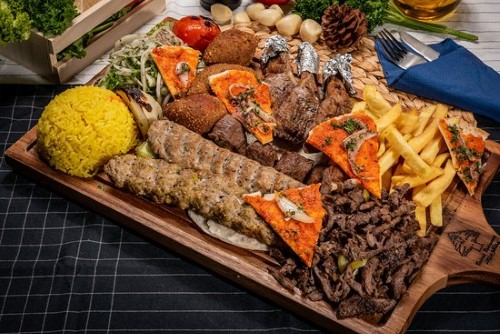
Main courses :
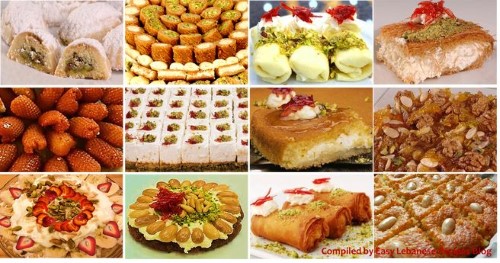
Desserts :
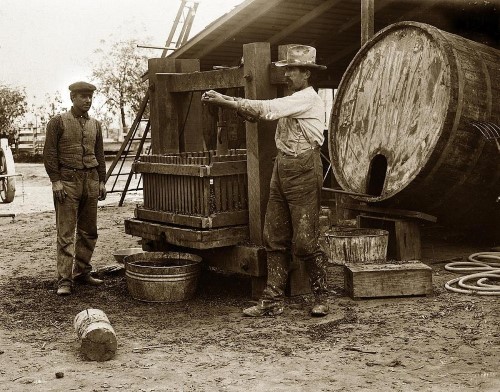
OENOLOGY
We often forget it but Lebanon is one of the cradles of viticulture…
The Bekaa Valley has always been considered as Lebanon’s most renowned viticulture center. It is in fact in Baalbek where the temple of Bacchus (Greek god of agriculture, wine and fertility) can be found, built around the second century A.D.
Thanks to the various mountains and sea breeze, Lebanon has the perfect climate to grow grapes. The country benefits from perfect conditions for the development of the vines: resistance to parasite pressure, an ideal climate and rich soils. This is particularly the case in the Bekaa valley, the cradle of viticulture in Lebanon. Most of the quality wines are produced in the center, where the water reserves are rather generous and where the temperatures are relatively cool at night, allowing a good concentration and a good quality of grapes. In the North, the low rainfall induces necessary and important irrigation.
It can be said that not only is the area of vines destined for wine production, but demand is increasing each year, as is the reputation of the producers.
Lebanese wines hold an undeniable recognition and a quality hailed by the great tasters who consider some Lebanese wines as very fine wines.
Nature, Sports & Adventure
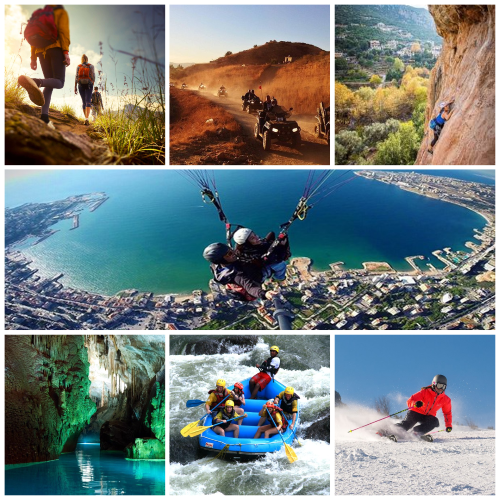
The blue sky and warm waters of the Mediterranean, the fresh air and rugged mountain peaks, and the pleasant chill of snowmelt-fed rivers make Lebanon a perfect destination for those who enjoy nature and the outdoors. From a leisurely afternoon of snorkeling or diving on the coast to a multiple-day trek through ancient cedar forests and mountains, the compactness of the country makes it possible to explore much of Lebanon’s natural beauty and the cultural diversity in a single trip.
In this country of rich biodiversity, nature-lovers will enjoy watching endangered loggerhead and green turtles come to shore for breeding along the southern coast, or going on guided nature walks in the north in search of tiny orchids, medicinal plants, and colorful wildflowers.
With a rich variety of terrain, adventure-lovers will find every outdoor sport under the sun. In summer, many seaside and mountain resorts offer the perennial favorites, such as swimming, water-skiing, tennis, golf, and parasailing. Diving and snorkeling are also very popular. You can explore Roman and Phoenician ruins off the coast of Saida (Sidon), Jbail (Byblos), and Sour (Tyre) or the wreckages of a World War II submarine at Khaldé, south of Beirut. In addition, ecolodges, clubs, and small outfitters offer mountain biking, guided hikes, rock climbing, rafting, archery, orienteering, and camps or other multi-day outdoor excursions throughout the year. In the winter, you can add downhill skiing, snowboarding, snowshoeing, and cross-country skiing across Lebanon’s snow-capped mountains to the list of outdoor activities.
For those seeking serious adventure and adrenaline, why not explore Lebanon from the air by paragliding or rock climbing to the more inaccessible rock-cut sanctuaries and hermitages hanging precipitously from steep mountain cliffs?
Caving in Lebanon is another unique experience. Considered one of the most beautiful caves in the world, the Jeita Grotto was discovered a hundred years ago. The cave is open to the public year round. For exploration of Lebanon’s other more remote caves, many clubs and small outfitters offer tours with experienced guides and all equipment provided.
Explore the Lebanon Mountain Trail
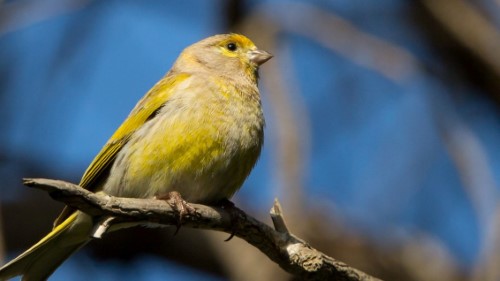
Bird Watching
Lebanon is an important stop-off point for migratory birds along African-Eurasian migration paths, creating a wealth of bird watching opportunities, especially during the spring and fall.
The peak bird watching seasons are mid-September through mid-October, and early March to mid-April.
Due to Lebanon’s diverse landscape, bird watchers are rewarded with a wide variety of species (over 300), including the rare chance to see magnificent but threatened birds such as the Imperial Eagle and the Sociable Lapwing. In addition, there are plentiful opportunities to see more common birds such as raptors, harriers, water birds, and others, like the Syrian Serin and the Palestinian Songbird.
There are three key areas for bird watchers to visit. The coastal reserves, including the Palm Islands Nature Reserve and the Tyre Coast Nature Reserve, are home to numerous sea and water birds. The mountains, with sites such as the Horsh Ehden Nature Reserve and the Al-Shouf Cedar Reserve, are known for eagles, vultures, and quails. Further inland, the marshes and plains of the Békaa Valley, such as the Aammiq Wetland, also offer plentiful bird watching opportunities. The southern village of Ibl Es-Saqi standing on the edge of a valley that functions as a unique corridor passage of migrating birds is also home to a small bird sanctuary. Trained guides are available in the nature reserves, and ecotour operators run bird watching hikes and treks through many of these beautiful areas.
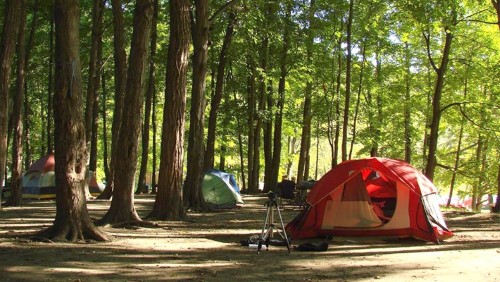
Camping
More and more camping options are emerging in Lebanon, and many existing sites are simply spectacular. Campers can set up their tents overlooking the sea north of Jbail (Byblos) and walk down from their site to the Mediterranean for a swim and some snorkeling. Alternatively, campers can retire in the Adonis Valley, home of the legendary frolicking of Adonis and Aphrodite of Greek mythology.
Lebanon offers numerous campsites and eco-lodges that have fully supported facilities catering to groups and families. These include platform tents or bungalow-style lodging, meals, and organized recreational activities such as hikes and mountain bike rides.
For those looking for a more remote nature experience, backcountry camping is allowed on any public land that is not in a Nature Reserve or Protected Area, but it is advisable to ask the local authority (Mayor's office) for approval. In these areas, camping is often part of an organized, guided excursion led by one of the country’s many ecotour operators. Camping can be a base from which to launch day trips to nearby towns and historic attractions, for hikes in surrounding natural areas, or simply as a quiet respite from the bustle of Beirut city life.
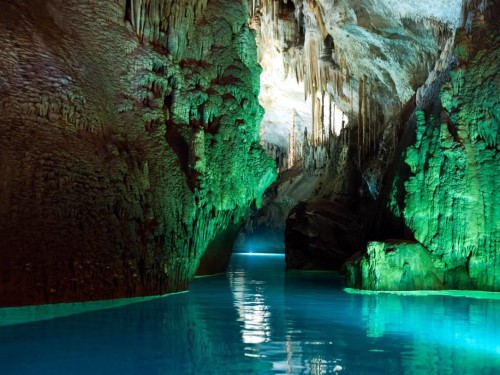
Caving
A mountainous and rocky country composed primarily of limestone, Lebanon offers exciting opportunities for caving. Over 400 caves, caverns, and sinkholes are scattered throughout the country, offering something for everyone, from the expert spelunker to the casual tourist. Most caves are concentrated in the Mount Lebanon region, stretching from north to south in the center of the country. The most popular and “touristy” of caves include the Jeita Grotto, with its huge caverns and underground lakes, and the enormous and intricate Afqa Grotto, source of the Adonis River where legend has it Adonis and Aphrodite exchanged their first kiss.
For the more adventurous tourists and experienced spelunkers, there are many other caving options that require guides and equipment. The Roueiss Grotto, for example, is a 5km long labyrinthine cave with an underground lake, large halls, and unique crystalline formations. Lebanon is also home to stunning vertical caves – called “sinkholes” or “potholes” – that are some of the deepest in the Middle East (up to 602 meters). These sinkholes are explored using ropes and climbing equipment, rappelling down into the hole and then climbing back up. Lebanon’s largest sinkholes are concentrated in the northern Mount Lebanon region, especially near Laqlouq and Tannourine.
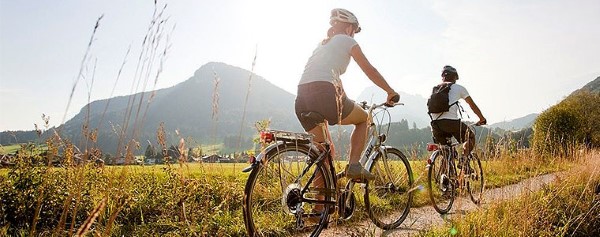
Cycling
Lebanon’s rugged mountains, hills, valleys, and its spectacular scenery immersed in history, make for some truly unique mountain biking opportunities. Cyclists can ride up Qornet Es-Saouda (Lebanon’s highest peak) with views of the Békaa Valley to the east, Syria to the north, and the Mediterranean Sea to the west. You can also ride through rugged mountainous terrain and Cedar groves in the Horsh Ehden and Al-Shouf Cedar Nature Reserves, and at the Cedars ski resort. The high plateaus of the Mount Lebanon Range are covered with extensive trail networks, offering technically challenging terrain for seasoned cyclists.
For those looking for more relaxed cycling, the Békaa Valley and the coastal regions have many opportunities both on and off-road. Many small villages have small shops offering bike rentals for independent on-road biking.
Most mountain biking is done with a guided tour, as many mountain trails are not well marked. Several tour operators run guided cycling tours catering to all levels, and include bicycle rental, lodging, food, insurance, an experienced guide, and transportation to and from the trailhead. Some clubs also organize Beirut Bike Tours.
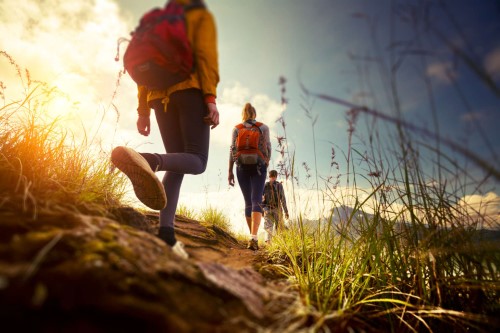
Hiking & Trekking
Varied terrain, scenic vistas, and historic environs combine to create unique hiking and trekking opportunities throughout Lebanon. Popular areas for hiking include the Tannourine Cedar Reserve, Horsh Ehden Nature Reserve near Tripoli, and the Shouf Biosphere Reserve, all of which offer good and extensive trail systems. Other areas with spectacular scenery and unique historical and cultural attractions include the Qadisha Valley, Makmel Park, and the remote Aakkar region in the North.
For a quintessential Lebanese experience, you can wander through the Adonis Valley, a ruggedly cut gorge sprinkled with historic ruins that is the site of Adonis and Aphrodite’s love story in Greek mythology. There are many trekking clubs and tour operators that run guided outings throughout Lebanon, ranging from leisurely day hikes to longer multi-day treks.

Mountain Climbing
Lebanon is one of the few places in the Middle East to offer a broad range of mountain climbing activities, from relatively easy summit climbs and technical peak ascents, to bouldering and adventure climbing. Limestone mountains, beautiful scenery, and easily accessible climbs welcome climbers to Lebanon.
The Aaquora, Tannourine, and Laqlouq regions have rock faces rated from 3 to 8 (on the French rating system), many of which are already bolted. There are also many interesting and technically challenging summits for mountaineering, including the 2,814 meter Mount Hermon and Mount Makmel, whose northeast face is an extremely technical climb.
Very few countries offer such great climbing located near such interesting cultural and historical attractions as Lebanon. For experienced climbers with their own equipment, topographic maps of climbing routes can be obtained from one of the country’s ecotour operators. Ecotour operators also organize a variety of guided climbing and mountaineering trips throughout the country, accessible for relatively fit travelers of all skill levels.
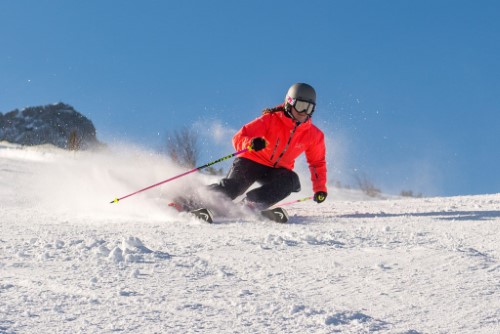
Skiing & Winter Sports
With six ski resorts catering to skiers and snowboarders of all skill levels, and with kilometers of backcountry Nordic cross-country and snowshoe trails waiting to be explored, Lebanon has something for everyone.
Each of the ski resorts boasts its own local flavor. For example, The Cedars Ski Resort (2,000-3,086m), near Mount Makmel (2,800m), is located on the highest range and offers the most scenic landscapes. Faraya-Mzaar (1,830-2,465m) is the best resort in terms of world-class infrastructure and facilities. Other resorts, such as Laqlouq (1,650-1,920m) and QanatBakiche (1,910-2,050m), are known for their family-oriented, friendly atmosphere. Faqra-KfarDibiane (1,735-1,980m) and Zaarour (1,700-2,000m) are private ski resorts, with special “peak” times reserved for members.
If you are seeking to evade the ski crowds, many outdoor adventure tour operators take groups on cross-country skiing and snowshoeing trips. Lebanon’s high plateaus are tailor-made for such Nordic pursuits.
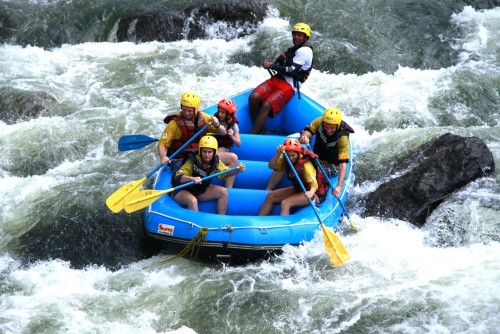
Water Sports
With 225km of Mediterranean coastline, as well as numerous rivers throughout the country, Lebanon offers many salt- and fresh-water sporting activities. Lebanon’s rocky coastline and underwater terrain make it a unique destination for snorkeling and diving. A 600m deep underwater valley runs from Beirut to the Bay of Jounié, creating interesting rocky gorges and underwater cliffs and dropoffs for divers to explore. Another popular diving area is at Chikka (near Tripoli), which offers some of the best marine landscapes and flora and fauna off the Lebanese coast.
Exploring the underwater ruins near Jbail (Byblos), Saida (Sidon), and Sour (Tyre) is another popular activity for divers and snorkelers; however, you are required to obtain a special permit to dive near archaeological sites. There are also several world-class shipwreck sites, including “le Souffleur” (a French submarine from World War II) near Khaldé, for underwater exploration. Lebanon’s coastline is lined with many private beach resorts and diving clubs offering facilities and equipment rentals for diving and snorkeling, as well as a variety of other water activities, including water skiing, windsurfing, and sailing. Nitrox equipment is available for technical deep-water dives.
While water sports in Lebanon are centered on the coast, there are also a number of freshwater activities, including rafting, kayaking, and canyoning. These are concentrated on the rivers of Nahr el Assi in Northern Bekaa, NahrLitani, in the South, and Nahr Ibrahim, In Jbail, which typically swell as the spring weather melts the mountain snows, creating great deep, fast water conditions. Many ecotour operators offer guided rafting and water sport activities on Lebanon’s rivers.
Ski Resorts
Mountains are an ideal place for a relaxing and peaceful retreat. The Lebanese mountains in particular offer a friendly and unique atmosphere for skiing and snow activities during winter.
The Cedars, Kfardebian, Laklouk and Zaarour are the top four destinations that come to mind when we think of white summits. Let’s take a closer look at each one and see what to do there!
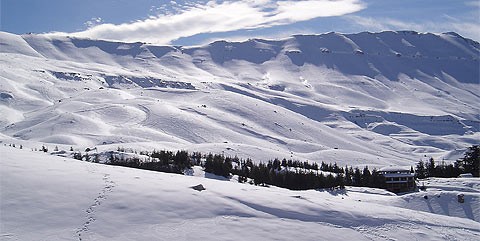
1. The Cedars:
The Cedars forest is one of the main tourist attractions in Lebanon. The forest has been mentioned and referred to many times in the Bible, and its rich history has made this area one of the most important tourist destinations in the Middle East.
Today, it is a preserved area and is being turned into an open art museum by renowned artist Rudy Rahme who is transforming dead cedar trees into works of art.
Nature lovers will find paradise on earth in this region endowed with breathtaking landscape and natural wonders for the eye.

2. Mzaar Kfardebian:
Mzaar Kfardebian is a ski area in Lebanon and the largest ski resort in the Middle East. It is located one hour away from Beirut, the capital of Lebanon. It is also referred to as Ouyoune el Simane.
The skiing season in Lebanon is similar in length to that of the Alps stretching over a period of 4 months. Skiers, snowboarders, snowmobile addicts, cross-country lovers and paragliders come to Mzaar from all parts of the country. Starting at 1850m, you may reach the 2465m peak of Mzaar and enjoy the breathtaking view over the colourful Bekaa valley, Mount Hermon of the Anti-Lebanon Mountain Range and other peaks like Laqlouq and The Cedars. Coastal towns and even Beirut, the capital, may be seen on a clear day.
Those who want a break from skiing at Mzaar should consider visiting the stunning 30 metre natural bridge of Kfardebian formed by wind and water erosion, and also ruins of a Phoenician temple and a Roman tower in nearby Faqra.

3. Laklouk:
Laklouk is a winter and summer resort, situated on a plateau at an altitude between 1750m and 2000m, and encircled by jagged ridges and terraces bearing thousands of trees.
In addition to alpine skiing, it is also one of the best resorts suited for cross country skiing. Mostly visited by families, Laqlouq had its first ski lift installed in 1958, followed by major enhancements to the slopes and the creation of a very qualified ski school.
Unlike other resorts, the area surrounding the slopes is nearly free of buildings and construction.
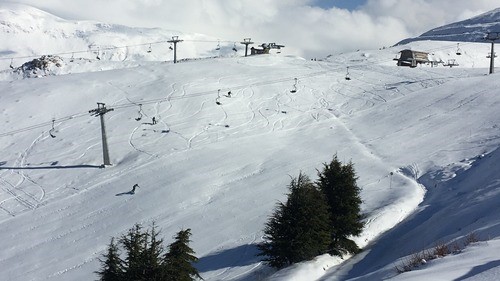
4. Zaarour
Zaarour Club is only 35km away from Beirut and hence the closest ski resort to the capital. It is easily accessible from several regions like Broumana, Bikfaya, Baskinta, Zahleh, and Aintoura. From Beirut, the fastest route is the Metn Highway.
The club's idyllic setting with its relaxing mountainous scenery and wide choice of activities makes it an ideal getaway for a day, a weekend or even longer stays.
The ski station, with its reconstructed north-facing slopes enhances your sports experience. Here exceptional snow quality combines thrills and convenience
Museums in Lebanon
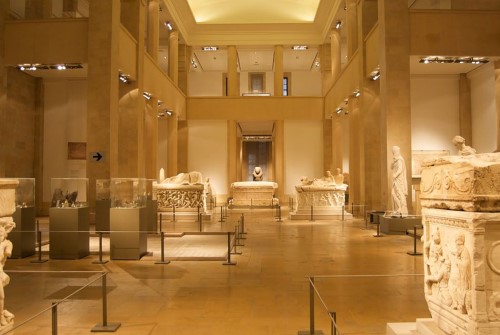
The Lebanese cultural heritage combines the ruins of temples, castles and streets, statues, monuments, sarcophagus, funeral steles, thrones, inscriptions, mosaics, as well as relics including of tools, offerings, jewelry, utensils, armory and coins… All that in addition to modern artworks of sculpture, paintings, music and more.
Based on this cultural and architectural richness found in Lebanon and accumulated throughout the ages, Lebanese museums were established in order to preserve this distinguished heritage and to also make it accessible to the public.
Today, Lebanon has many public and private museums spread all over the country and some are found inside archeological sites (Beiteddine, Baalbek, Byblos etc.), or inside monasteries and religious shrines. Besides, there are private museums named after some Lebanese craftsmen, artists, writers and intellectuals that took Lebanon to a higher standard.
History & Civilizations
A trip through Lebanon is a journey through the annals of some of the world’s greatest civilizations. With over 5,000 years of recorded history, the country is a treasure trove of archaeological wonders, waiting to be discovered by visitors who want a glimpse into the ancient and modern past. Most of Lebanon’s historical sites have layers upon layers of ruins, with each layer uncovering the story of another civilization that inhabited this ancient land.
Prehistoric Times (5,000-3,500 B.C.)
A trip through Lebanon’s history begins in Jbail (Byblos), where archaeologists have discovered the earliest known settlements in Lebanon. Today, remnants of prehistoric huts with crushed limestone floors, primitive weapons, and burial jars are evidence of the Neolithic and Chalcolithic fishing communities who lived on the shore of the Mediterranean Sea over 7,000 years ago.
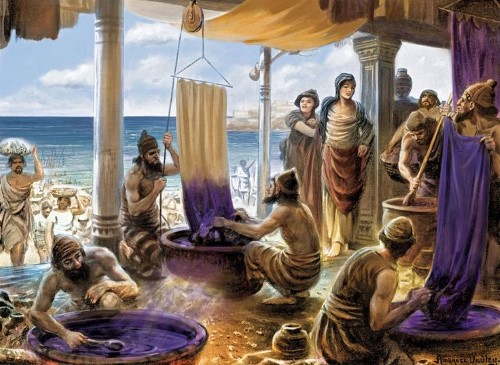
Phoenicians (3,500-334 B.C.)
Lebanon first appeared in recorded history around 3,000 BC, with the settlement of the area by the Canaanites. The Canaanites established great maritime, trade, and religious city-states in several of Lebanon’s coastal cities: Jbail (Byblos), Sour (Tyre), Saida (Sidon), and Beirut. The Greeks referred to these Semitic people as “Phoenicians,” after the Greek word for the expensive purple-dyed textiles that the Phoenicians exported.
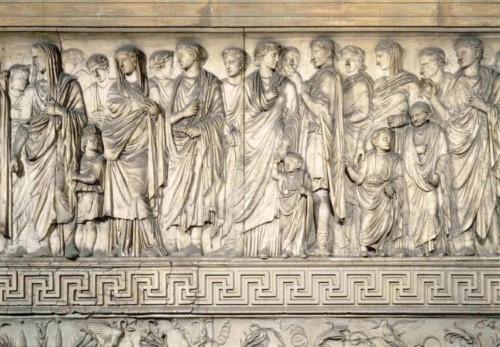
Greeks (333-64 B.C.)
In 333 B.C., Alexander the Great conquered the Phoenician city-states, and ancient Phoenicia was absorbed into the Greek Empire (which covered Europe, North Africa, and the Middle East). Greek customs and the Greek language were adopted. Alexander the Great died in 323 B.C. (only 10 years after his conquest of the Middle East), and over 250 years of unrest and dynastic struggles followed. Greek rule in the region was finally overturned by the Roman General Pompey in 64 B.C.
While there are no significant ruins from the Hellenistic period in Lebanon, one notable Greek site for history-lovers is in Sour (Tyre). While most of the Phoenician cities submitted immediately to Alexander the Great’s conquest in 333 B.C., Sour (Tyre) resisted in a year-long siege that destroyed much of the city. Alexander used the debris from the abandoned mainland city to build a causeway to reach the fortified island city and eventually conquer the Tyrians. Today, this causeway has been enlarged with sand to form a peninsula that connects the ancient island city to the mainland. As you walk between the major archaeological sites in Sour (Tyre), you will cross this “Quarter of Sand” (Hay El-Ramel) that was once Alexander’s causeway.
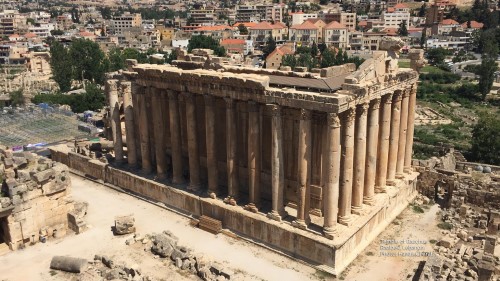
Romans (64 B.C. - 399 A.D.)
Roman rule in Lebanon lasted over 300 years. During this period, the old Phoenician cities continued to grow and prosper as centers of industry and commerce. The coastal cities (Saida, Sour, Beirut) exported cedar, perfume, jewelry, wine, and fruit to Rome and served as trading centers for goods imported from Syria, Persia, and India. Local industries, including the production of silk, glass, purple-dyed textiles, and pottery, flourished under the Romans. Temples and palaces were built throughout the country, as well as paved roads that linked the cities. Christianity also spread to Lebanon during this era, and flourished as the Roman emperors officially adopted the religion.
For a modern-day visitor, it is difficult to travel more than a few kilometers in Lebanon without running into a Roman-era ruin. The country is home to some of the best-preserved and most impressive Roman sites in the world, most notably at Baalbek and Sour (Tyre).

Byzantines (399-636 A.D.)
The Byzantine era in Lebanon began with the split of the Roman Empire in 395 A.D. into the eastern/Byzantine part (with its capital at Constantinople) and the western part (with its capital at Rome). As the Western Roman Empire declined, the Byzantine Empire grew and commercial and intellectual growth in Lebanon’s cities continued.
However, around the 5th and 6th centuries A.D., ecumenical debates and corruption in the church led to increasing unrest. From this religious dissension, the Maronite Church was established and took refuge in the mountainous Qadisha Valley region of Lebanon, and the Valley has remained a place of spiritual refuge and pilgrimage to this day. There are many archaeological remains of Lebanon’s Byzantine era around the country, many built on top of and added to previous civilizations’ cities and sites.

Arabs (660-1258 A.D.)
Many clashes took place at this period between the Byzantine Empire and its opponents mainly the Muslims whose widespread reached the borders of the empire.
The Umayyad Dynasty, which flourished for 100 years (660-750 A.D.) in the first century after Muhammed, was the first of two dynasties of the Arab Islamic empire. The Umayyad caliphs were notable for establishing a large empire, which extended from Spain, through North Africa, to Central Asia. They established Arabic as the official language of the empire, and they are remembered for their excellent city administration and planning and their patronage of early Islamic art and architecture. Following a coup, the Umayyads were replaced by the Abbasid Dynasty (750-1258 A.D.), who shifted power eastward to Baghdad and imposed harsh control in Lebanon and Syria, leading to many local revolts.
Under Arab rule, the region of Lebanon became a refuge for many ethnic and religious groups. Splinter Christian groups, including the Maronites and the Melchites, settled in the Qadisha Valley and Zahlé. Islamic followers of an Egyptian caliph settled in southern Lebanon and established the Druze sect, still a major religious group in the Chouf and other areas of modern-day Lebanon. Shiite Muslims from Egypt also had increasing influence in the region during this era.
Lebanon’s cities continued to prosper as trading and industrial centers under Arab rule. However, there are few archaeological remnants of this period in Lebanon today.
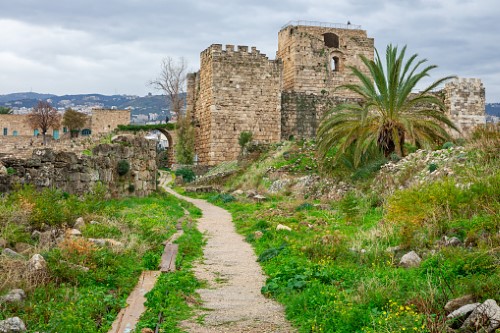
Crusaders (1099-1291 A.D.)
As Arab leadership fragmented, and following Caliph Al-Hakim’s occupation of Christian holy places in Palestine and destruction of the Holy Sepulcher, the Christians of western Europe undertook a series of “Crusades” to recover the Holy Land from the Muslims. The European Crusaders joined with the Byzantine army to take Jerusalem and then marched along the Lebanese coast. Between 1109 and 1124, Lebanon’s key cities (Tripoli, Beirut, Saida, Sour) were all conquered by the Crusaders. Soon after, the Muslim reconquest began, led by Saladin, with the region returning to Muslim control by 1291.
One lasting influence of the Crusades in Lebanon was the creation of renewed linkages between the Maronites and the Roman Catholics. In 1180, the Maronite Church entered a formal union with the Roman Catholic Church, a union that still exists today. There are also numerous archaeological remnants (towers, castles, and churches) of the Crusades scattered along the Lebanese coast and throughout the countryside. Notable sites include:
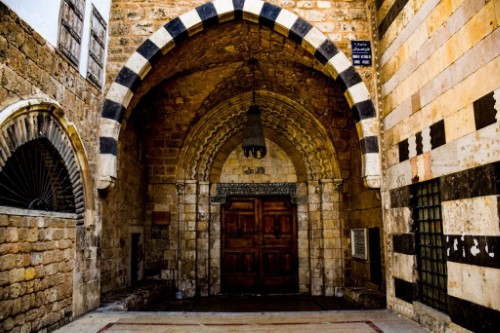
Mamlukes (1250-1516 A.D.) & Ottomans (1516-1914 A.D.)
Following the Crusades, modern-day Lebanon, Syria, and Egypt came under the control of the Mamlukes. The Mamlukes were originally slave bodyguards (from the Caspian and Caucasus regions) for the Egyptian Ayoubid sultans. However, the Mamlukes overthrew their masters and formed the Mamluke Sultanate. Many Shiite Muslims migrated to Lebanon during this period, and there were increasing religious tensions. After a number of rebellions near Beirut were crushed, the Shiites moved to settle in Southern Lebanon.
The Mamlukes were defeated by the Turkish Ottomans in 1516, and the Ottomans dominated the region for the four centuries preceding World War I.
A tour in the Lebanese History
At origins: Archeologists in Lebanon have discovered remnants around a million years old, and human traces from the Paleolithic era (around 8,500 B.C.) in grottos.
The Phoenician Era: The history of Lebanon as we know it starts with the Cannanean – Phoenician civilizations. Around 3,500 B.C., the Phoenicians put up their trading counters on the Lebanese coast. These trading city-states rapidly become small yet wealthy kingdoms, like Byblos, Tyre, Sidon, and Arados.
800 B.C.: The Phoenician’s long-lived prosperity starts to decline with the uprising of the Assyrian empire. The latter will be followed by the Babylonians, the Persians and the Greeks.
64 B.C.: The last of the Phoenician cities surrender to the Syrian province of the Roman Empire after their conquest of Pompée.
Up to the year 395 A.C.: Commercial and cultural activities prosper and Christianity develops under the Roman domination. Then the Byzantine Empire takes over the control of the region.
637 A.C.: Lebanon is conquered by the Arabs and becomes a state of the Omayyad califes before it becomes dominated by the Francs from 1099 to 1291 A.C.
1291 to 1516 A.C.: The crusaders are driven away by the Mamelouks who develop Beirut’s commercial port’s activities.
1516 to 1918 A.C.: The Ottomans reign over the country as masters, however leaving its management to the local emirs.
During the 19th century: Lebanons’ fate vacillates between the Ottoman power and an autonomy that was imposed by Europe. The latter supported the local development of religious communities. A portion of the country’s population, supported by the Europeans, demands its autonomy.
1841: The Mount Lebanon Province is divided into two districts: to the North, the maronites (Bikfaya and the Metn), and to the South the Druze (Beit ed-Dine and the Chouf).
1860: Following the massacre of thousands of Christians by the Druze and Ottomans, Napoleon the 3rd sends an expeditionary mission to Lebanon. This will lead to the autonomy of Lebanon in 1864.
1866: The American University in Beirut is founded.
1875: The St Joseph University is founded.
1916: France and Great Britain sign the Sykes-Picot treaties. Russia ratifies the treaties which separate the Ottoman Empire into influential zones. France awards itself the libanese-syrian coastal strip, among other territories.
1920: Marks the start of the French mandate following the signature of the Sèvres treaty. The state of Great Lebanon is proclaimed.
1943: The independence of the Lebanese Republic is effective on the 22nd of November. Bechara El-Khoury and Ryad Solh conclude a “national pact” which sets the rules of representation for each religious community.
1945: Lebanon participates to the foundation of the Arab League.
1946: French troops leave Lebanon from March to December. The first twenty years of independence are those of great economic prosperity in the Lebanese Republic.
1958: Lebanon is shaken by a civil war (May till September) that is motivated by a disagreement on Egypt and Syria’s joining into the United Arab Republic. President Camille Chamoun, who was opposed to Gamal A.Nasser, calls the United States to the rescue in an effort to save his regime. American troops are sent to Lebanon, however it is the election of President General Chehab that will resolve the crisis. The latter will conduct a policy centered on Arab solidarity.
1967: The 6 Days war drives around 450,000 Palestinians to find refuge in Lebanon.
1969: The first conflict between the Lebanese Government and the Palestinian movement leads to the Cairo agreements which authorized the presence of the Palestinian army in South Lebanon.
1973: Confrontations between the Lebanese army and the Palestinian PLO (Palestinian Liberation Organization) militia become more and more frequent. Moreover, a number of Palestinian leaders are assassinated by the Israeli commandos. Tension builds up and leads to the burst of the civil war in April 1975.
1975 to 1989: Lebanon endures the civil war.
1976: Syrian troops make an entry in Lebanon in June.
1978: The Syrian troops turn against the Lebanese “Phalangistes”, while Israel occupies the southern Lebanese territory up to the Litani river.
1982: Israel initiates operation “Peace in Galilee” and reaches Beyrouth. The siege of the capital forces the PLO and its leader to flee Beyrouth. The same year, the massacres of the Sabra and Chatila camps are perpetrated.
1984: The Multinational Peace Force leaves Lebanon as violence takes on new heights.
1985: Israel retrieves from the Lebanese Territory but retains the control of a “Security Zone” on the Southern border.
1989: The Taëf agreements are signed on the 22nd of October in Saudi Arabia, thus putting an end to the civil war. The agreements recommend an equitable redistribution of power and a revision of the Lebanese constitution. Following the assassination of President René Moawad, Elias Hraoui is elected to the Presidency of the Lebanese Republic.
1990: The 2nd Lebanese Republic is proclaimed.
1991: Lebanon and Syria sign a common treaty. The new national coalition government summons the break down of armed militias.
1992: Rafic Hariri is elected Prime Minister in October, and the reconstruction of the country and its capital begins.